Indus Valley Civilization
he Indus Valley Civilization, also known as the Harappan Civilization, was one of the world’s earliest urban cultures, flourishing around 3300 BCE to 1300 BCE in what is now Pakistan and northwest India. It was contemporary with ancient Egypt and Mesopotamia, and it was the most widespread of the three, covering a vast area including modern-day Pakistan, northwest India, and northeast Afghanistan

Key Features of the Indus Valley Civilization
- Urban Planning: The cities of the Indus Valley were known for their advanced urban planning. They had well-organized streets laid out in a grid pattern, sophisticated drainage systems, and large public buildings.
- Architecture: The houses were built with baked bricks and had flat roofs. Many homes had their own wells and bathrooms, indicating a high standard of living.
- Economy: The economy was primarily based on agriculture, with wheat, barley, and peas being the main crops. They also engaged in trade with neighboring regions, including Mesopotamia.
- Craftsmanship: The people of the Indus Valley were skilled craftsmen. They produced beautiful pottery, jewelry, and tools made of copper, bronze, and stone.
- Writing System: The Indus script, which remains undeciphered, was used for administrative and possibly religious purposes.
- Religion: Little is known about their religious beliefs, but they likely worshipped a mother goddess and a male deity resembling Shiva
Major Sites
Harappa:
Harappa is an archaeological site in Punjab, Pakistan, about 24 kilometers west of Sahiwal. It is one of the earliest sites of the Indus Valley Civilization (IVC) to be excavated. The site takes its name from a modern village near the former course of the Ravi River2. Harappa was first excavated by the Archaeological Survey of India during the British Raj, and its significance became more apparent with the discovery of Mohenjo-daro. The site is known for its well-planned urban layout, including a citadel, lower city, and cemeteries

Mohenjo-daro:
Mohenjo-daro, located in Sindh, Pakistan, is one of the most famous archaeological sites of the Indus Valley Civilization. It was discovered in the 1920s and is renowned for its well-planned urban layout, advanced drainage systems, and impressive architecture. One of the most significant features of Mohenjo-daro is the Great Bath, a large public bathing area that indicates the importance of ritual bathing in the culture.
Mohenjo-daro means “Mound of the Dead Men” in Sindhi. The city’s layout includes a citadel (fortified area) and a lower city, with residential, administrative, and religious buildings. The city’s planning reflects a high degree of social organization and engineering skills.

Dholavira:
Dholavira, located in Gujarat, India, is one of the most remarkable sites of the Indus Valley Civilization. It is renowned for its advanced water conservation system, which is considered one of the earliest and most sophisticated in the world. The system includes a network of interconnected reservoirs, channels, and dams that were used for storing and distributing water for various purposes2.
The water management system at Dholavira consists of large reservoirs designed to store water during the monsoon season, preventing wastage and ensuring a steady supply throughout the year. These reservoirs were connected by channels and dams that distributed water to the surrounding areas for irrigation and domestic use2. The use of check dams to collect rainwater and prevent soil erosion is another notable feature of this system.
The discovery of this water management system highlights the advanced engineering skills and knowledge of the people of the Indus Valley Civilization and underscores the importance of water management in sustaining agricultural practices

Decline
The decline of the Indus Valley Civilization is still a subject of research. It is believed that a combination of factors such as climate change, drying up of rivers, and possibly invasions led to its gradual decline around 1900 BCE
Art and Craftsmanship
The Indus Valley people were skilled artisans. They produced exquisite beadwork, pottery, and terracotta figurines. The beads made from semi-precious stones like carnelian and lapis lazuli were highly valued. They also crafted intricate jewelry and tools using metals such as copper, bronze, and gold.
Writing and Seals
The Indus script is one of the most enigmatic features of the civilization. Found on numerous seals and pottery fragments, this script consists of pictographic symbols. Despite numerous attempts, it remains undeciphered. The seals, often made of steatite, depicted animals, mythological creatures, and sometimes human figures, possibly serving as a form of identification or trade document.
Trade and Economy
The Indus Valley Civilization had extensive trade networks. They traded with neighboring regions, including Mesopotamia, Afghanistan, and Central Asia. The discovery of Indus seals in Mesopotamia indicates a well-established trade relationship. The civilization’s economy was primarily agrarian, with wheat, barley, peas, and cotton being the main crops. They also domesticated animals like cattle, sheep, and goats.
Social Structure
The society of the Indus Valley Civilization appears to have been egalitarian, with no clear evidence of a ruling elite or centralized government. The uniformity in the layout of houses and the distribution of resources suggests a relatively equal society.
Decline Theories
The decline of the Indus Valley Civilization is still a subject of scholarly debate. Several theories have been proposed:
- Climate Change: A shift in climate might have led to the drying up of the Ghaggar-Hakra River, which played a crucial role in sustaining their agriculture.
- Earthquakes: Seismic activity could have caused changes in the river courses, leading to floods or droughts.
- Aryan Invasion: Some scholars suggest that the arrival of the Indo-Aryans might have led to cultural changes and the eventual decline of the civilization. However, this theory is controversial and not widely accepted.
Cultural Influence
The Indus Valley Civilization had a profound influence on later cultures in the Indian subcontinent. Elements of their urban planning, craft techniques, and possibly religious practices were carried forward by subsequent cultures.


I am really inspired with your writing talents and also with the layout for
your weblog. Is this a paid topic or did you modify it your
self? Either way stay up the nice high quality writing, it’s uncommon to look a great blog like this one these days.
Instagram Auto comment!